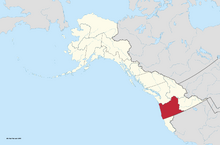| The following Russian America page is under construction.
Please do not edit or alter this article in any way while this template is active. All unauthorized edits may be reverted on the admin's discretion. Propose any changes to the talk page. |
Летит на собственных крыльях (Russian) ("Fly on the wings of their own") | ||||||
| Capital | Dolinnoye Serdtse | |||||
| Largest City | Vladikaskady | |||||
| Other Cities | Pokatello, Yevgenyevka | |||||
| Language Official |
Russian (de facto) | |||||
| Others | English, Spanish, Ukrainian | |||||
| Religion Main |
Eastern Orthodox | |||||
| Others | Catholics, Pentecostals | |||||
| Ethnic Groups Main |
Russians and Ukrainians | |||||
| Others | English, Germans, Norwegians | |||||
| Demonym | Oregonian | |||||
| Governor | Klavdia Pavlovich (DMS) | |||||
| Area | 353,945 km² (311,007 кв. врс) | |||||
| Population | 6,820,412 | |||||
| Established | February 10, 1841 | |||||
| Admission | January 3, 1931 | |||||
| Time Zone | (UTC-8 to -7) | |||||
| Summer | (UTC-7 to -6) | |||||
| Abbreviations | AK-OR, Оре. | |||||
The Governorate of Oregon (Russian: Орегонская губерния, Oregonskaya guberniya), commonly known as Oregon (Орегрн), is a governorate of the Alaskan Democratic Federative Republic. Located in southern Alaska, Oregon is bordered by Sonoma and Mexico (via Nevada and Utah) to the south, Columbia and Idaho to the north and east, and the United States to the east. Oregon is one of the largest governorates, and the most populated governorate (with the largest city Baranovsk being among the top five largest cities).
Along with the Russians, the territory of modern day Oregon were once claimed by the Americans, the British, and the Spanish. Following the Russo-Spanish War (1822-1865) and the subsequent treaties with the UK and US (1826-1828), the territory south of the Columbia River became completely Russian territory.
To prevent losing the territory, many of the early settlers to Oregon were exiles and prisoners (making the territory into a penal colony), with the area of the Willamette Valley being left for legitimate settlers from Russia (and some from the United States). Following the discovery of gold in Sonoma, Oregon simultaneously witnessed a boom as more settlers flocked to the region. The new wealth allowed for industrialization of the area, and the first railway system in the area was the Ross and Oregon Railroad (R&O).
During the early 20th Century, Oregon was the center of the radical republican factions of the Nasha Amerika movement, supporting the complete independence of Russian America from the Russian Empire. Following the Russian Revolution in 1917 and the declaration of the First Alaskan Republic, Oregon (along with Columbia and Sonoma) declared its independence as the Oregonian Republic. Columbia and the other English-speaking regions later split off as the Republic of New Albion, with Sonoma declaring independence after Oregon refused to consider a federation. To prevent the rural and Baptist regions of Oregon from also seceding, Vladikaskady allowed them some autonomy (the area would later form the core of Idaho).
Oregon unites with the Alaskan Democratic Republic to establish the Alaskan Democratic Federative Republic in 1929. Following the support for smaller states in 1940, Oregon was the only governorate to initially refuse to give up territory. Two governorates were initially proposed, but Oregon eventually agreed to relinquish its territory northeast of the Snake River (with the territory becoming Idaho). This now gave Oregon a unique panhandle that stretched all the way to the US border, despite the residents there supporting the idea of a Mormon-dominated governorate. Because of its large size and diverse demographics, Oregon has become a swing-governorate during elections, with the Willamette Valley being liberal and the panhandle being conservative.
Template:RA-Alaska


